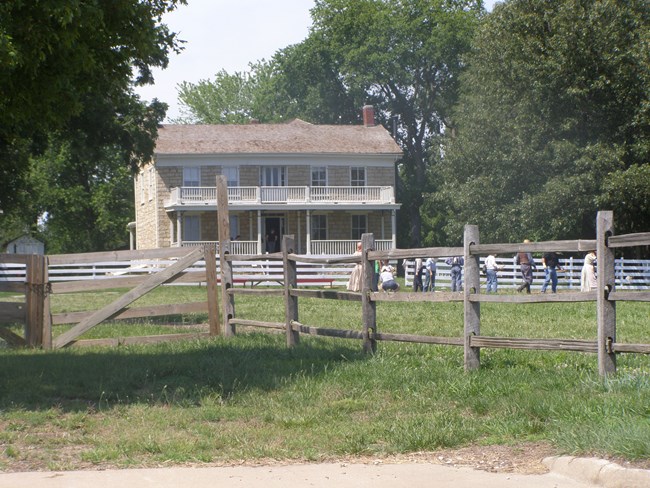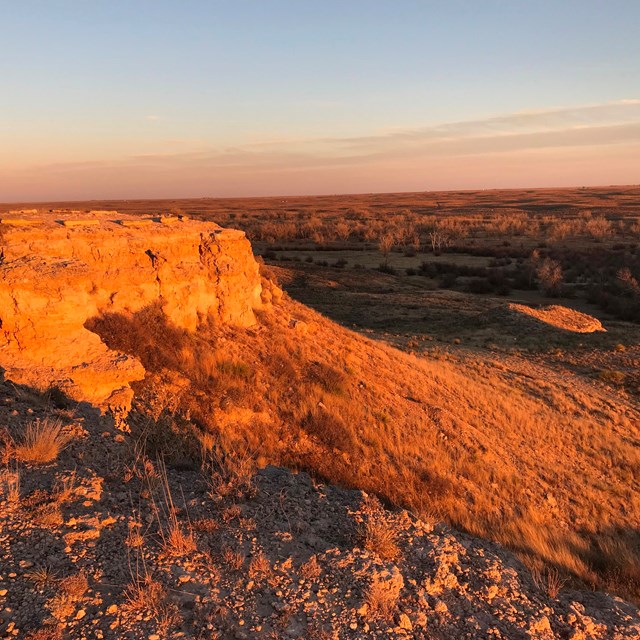Part of a series of articles titled University of New Mexico Student Essays: Santa Fe National Historic Trail.
Article
University of New Mexico Student Essay: Mahaffie House

Photo/Chris Light
Mahaffie House
Located in northeastern Kansas just southwest of Independence, Missouri, the Mahaffie farmstead was an important stage stop along the Santa Fe Trail where travelers stocked up for their journey westward. The house is a rare historical structure with good integrity and enough space to accommodate the visiting public who desire a taste of Kansas's pioneer spirit.
Historic Significance
The Mahaffie House and its surrounding outbuildings constituted the first hotel and stage station in its section of Johnson County, Kansas. As a whole, the property is testament to the ways that private citizens far from Santa Fe played a role in opening trade with New Mexico. Present-day visitors can see the contrast between northeastern Kansas's rural past and its modern urbanized form. The unchecked growth of nearby Kansas City makes the preservation of the Mahaffie House--an important link to Johnson County's yesteryears--even more vital. The house is the only known Santa Fe Trail stage station that remains open to members of the public.
Property Details
The Santa Fe Trail ran right across the southwest corner of the property, providing travelers with ready access to the farmstead. Stage stops were essentially multi-dimensional convenience stores--in addition to hot meals and other provisions, they offered hospitality, shelter, and relative safety. The property actually contains three structures listed on the National Register of Historic Places: the house, a wood peg barn, and a stone ice house.
Who Was J. B. Mahaffie?
James Beatty Mahaffie was born in Ohio in 1817. He married Lucinda Henderson in 1844, and the two made their home in Logansport, Indiana. When he first arrived in Kansas Territory in 1857, he found pro-slavery Missourians occupying all the good plots of land so he did not stay long. Kansas Territory was organized under popular sovereignty, meaning that the question of whether slavery could be practiced there was left to the territory's voters; because of this, large numbers of Americans moved there during the 1850s to cast votes for or against slavery. Mahaffie eventually returned to Kansas and bought a house and a separate plot of land. With the help of oxen, he moved the house to the plot in 1858.
Mahaffie the Pioneer
Although a transplant from Ohio, Mahaffie is remembered as "one of the leading farmers of the area." He was also "active in local social and political affairs"; in 1858 he was elected chairman of the Johnson County supervisors. Mahaffie belonged to the Grange, a post-Civil War organization dedicated to the political and economic advancement of rural communities. His passion for developing the county extended to railroad politics, and he served on the first board of directors of the Missouri River, Fort Scott, and Gulf Railroad—the predecessor of the company that would finally bring the railroad to Olathe in 1869. Later in his life, Mahaffie advocated the preservation of the Santa Fe Trail.
The House
The first night Mahaffie moved his house to his newly-purchased property in 1858, he took in $5 (roughly $150 today) from travelers--just for the privilege of sleeping on his wooden floors! Mahaffie's farmstead soon became known for its hospitality. Communal dinners were served in the basement. Mahaffie completed a large stone addition in 1865; that same year, he had the largest farm (570 acres) and the largest livestock herd in Olathe.
Architectural Details
The house sits roughly 500 feet north of the Kansas City Road, which once served as a portion of the Santa Fe Trail. The house, which sits on a thirteen-acre parcel, was constructed somewhere in Olathe in 1857 and moved to Mahaffie's plot in 1858. It was originally one-and-a-half stories tall until Mahaffie added a two-story stone addition on the structure's southern side; Mahaffie later raised the adjoining frame structure so it stood two stories tall, as well. A one-story porch on Tuscan columns faces the old Kansas City Road. Though the house is not especially significant architecturally, it is a good example of vernacular style.
The End of the Mahaffie Era
Mahaffie retired from the farm in 1881 and sold the property in 1883. The era of the stage station had largely passed, thanks to the end of the Civil War and the beginning of the railroad era. The property passed through different owners until the City of Olathe purchased the property in 1980 with funds from citizens, grants, and the city government. In 1982, a federal grant to improve the Mahaffie House provided a new roof, forced air heating, and new wiring. It is relatively unusual for a city to own/operate a historic site as important as the Mahaffie House.
Visit the House
The Mahaffie Farmstead is still used for agriculture, but it is primarily tourist attraction. It remains the only known Santa Fe Trail stage station that is open to the public. The house is located at 1200 E Kansas City Road, Olathe, KS 66061. It is generally open from 10 am to 4 pm, depending on the season.
---
“About Us.” Mahaffie Stagecoach Stop & Farm Historic Site. https://www.mahaffie.org/about-us (accessed 16 November 2020).
Duncan, Michael E. "Mahaffie Farmstead and Stagecoach Stop Historic Site." Wagon Tracks 1, no. 3 (May 1987): 4.
National Park Service. Santa Fe National Historic Trail Draft Comprehensive Management Plan. Denver, Colo.: U.S. Department of the Interior, 1989.
Pankratz, Richard. "J.B. Mahaffie House." National Register of Historic Places Inventory/Nomination Form. Topeka: Kansas State Historical Society, 1977.
Note: This collaborative research project was formulated to give students of all levels in the University of New Mexico’s Department of History valuable academic and professional experience while also providing trail partners (and the general public) with useful essays on historic trail sites. This particular essay comes from a student in Dr. Fred Gibbs’ class on the national historic trails in fall 2018. More information on the collaboration that made this course possible.
Last updated: January 26, 2021


